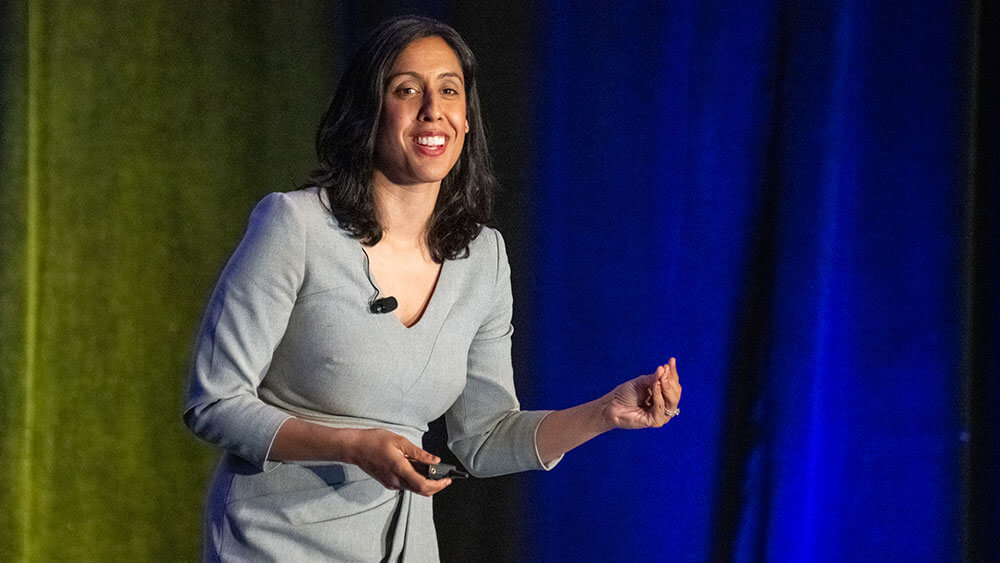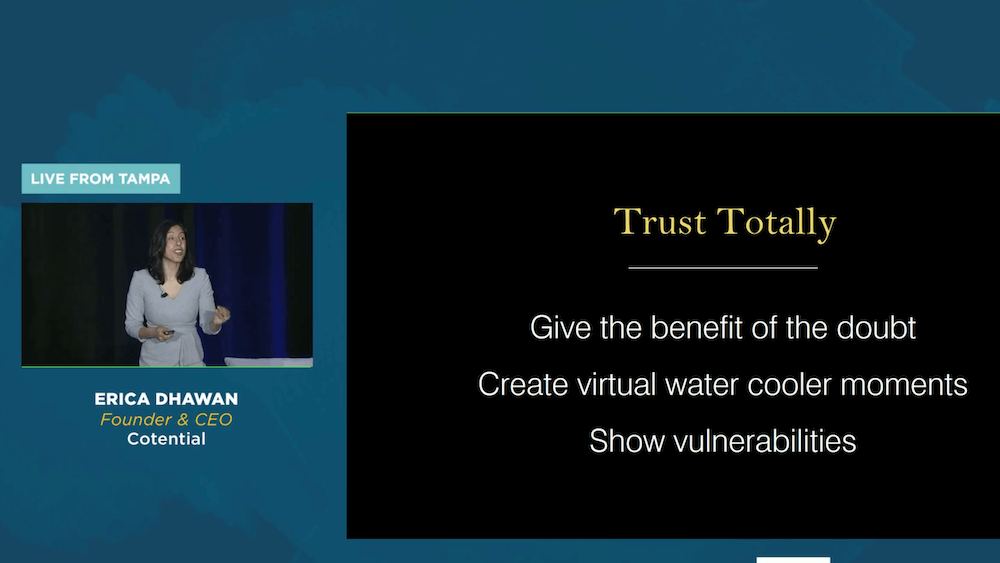
Digital teamwork expert Erica Dhawan spoke at Destinations International’s CEO Summit about the importance of being less “visually biased” in hybrid environments. (Courtesy Destinations International)
“As we think about the last year, we all know that connecting intelligently is not as easy as it sounds,” Erica Dhawan said at Destinations International’s hybrid 2021 CEO Summit, held May 25-27 in Tampa, Florida, and online.
Dhawan, author of the hot-off-the-press Digital Body Language: How to Build Trust & Connection No Matter the Distance, helps organizations and teams get big things done with the power of what she calls “connectional intelligence” — the capability to unlock new and unrealized business value by fully harnessing the power of our networks and relationships. Digital Body Language, published in May, builds on the foundation of Get Big Things Done: The Power of Connectional Intelligence, a 2015 book Dhawan coauthored, and explores how to forge connections in the context of digital work environments brought about by the pandemic.
Virtual communication — via email and conference calls — has been important to organizations for years, but that has shot up to 100 percent in the last year, Dhawan said, due to the pandemic. This, she said, is the opportunity for professionals to reimagine collaboration, particularly when it comes to connecting in a hybrid setting.
“I’ll never forget that pre-pandemic, I was [once] on a conference call. Three people, me included, were remote, and three people were in the office. And it wasn’t until 26 minutes [into] a 30-minute meeting that someone in the office said, ‘Does anyone on the phone have something to share?’ We had been excluded the entire time.”
But now, Dhawan explained, the last year has allowed professionals to be “more geographically inclusive — less visually biased from who’s just in the room to allowing anyone to be part of a virtual room,” she said. “In today’s age, we need to be able to break silos, reduce duplicative work, find new synergies and alliances and ways that don’t rely on simply being face to face all the time.”
Dhawan gave a few examples of how connectional intelligence can improve the workplace, including one that transformed the way attorneys worked at a law firm: A few years ago, the chief financial officer of the firm noticed that the youngest associates were billing fewer hours than ever before — a strange occurrence, since the newest associates were often saddled with the most work. “When they dug into it,” Dhawan said, “they discovered that the youngest associates had created their own peer-to-peer, Twitter-type network to help each other solve cases faster. Questions like, ‘Where is this legal citation?’ or ‘Who has done this before?’ …It really taught those senior leaders they could learn from their youngest in the organization.”

Trust totally is one of Erica Dhawan’s Four Laws of Connectional Intelligence, which she shared with the CEO Summit online and in-person audiences.
After 10 years of research, Dhawan created the “Four Laws of Connectional Intelligence,” which she shared with the CEO Summit audience:
Value Visibility
“Prior to the pandemic, so many of the ways that we valued others was through eye contact, team meetings, offsites, and live events,” Dhawan said. “In today’s world, I like to say valuing visibly, especially in a hybrid context, is about valuing people’s time, valuing their inboxes, valuing their schedules. It’s not chronically canceling. It’s being thoughtful that providing an agenda in advance of a meeting can allow everyone to be ready to engage and feel valued for their time in that meeting. It’s about … asking ourselves not only why we are coming together, but how do we make sure everyone feels truly engaged? Not only those in the room, but those coming in virtually [too].”
Dhawan noted that it is also important to acknowledge individual differences in the hybrid space — introverts versus extroverts, adapters to technology, and those who don’t feel comfortable using it at all. “Take time to remember what was implicit in traditional body language has to be explicit in digital body language,” she said.
Communicate Carefully
“Reading messages carefully is the new listening and writing clearly is the new empathy,” Dhawan said. “It doesn’t matter if you’ve always been a face-to-face person; as a leader today in this industry, you need to be able to connect both in-person and from afar.”
Collaborate Confidently
“So much of our confidence was built through our body language and how we engaged face to face,” she said. “But we have to remember that as we move back to live events, we must stay inclusive of those in a hybrid context. And we must be able to equip our teams to collaborate regardless of the distance.”
Trust Totally
“We have to create virtual water cooler moments,” Dhawan said, “and we have to show vulnerability. The more we’re willing as leaders to show what’s hard about this, what we know and what we don’t know and where we need help, the more we will get insights from unexpected sources that will bring the best solutions to us.”
Casey Gale is associate editor at Convene.
